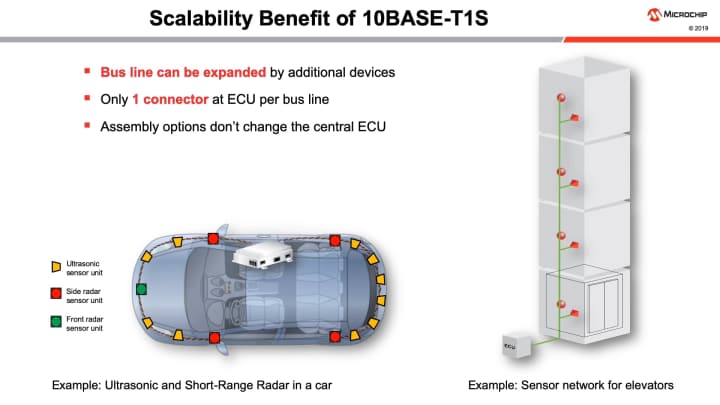10BASE-T1S Technology
10BASE-T1S is the latest technology used to expand Ethernet to the edge of Operational Technology (OT) and Information Technology (IT) networks—even when your network consists of incompatible devices and different physical hardware. Much like its utility in other sectors, this technology also brings significant advantages to the automotive industry. Established by IEEE®, 10BASE-T1S technology provides a 10 Mbps, multidrop transmission medium that can include up to at least eight transceiver nodes. The transceiver nodes connect to a common mixing segment of up to at least 25m. According to the IEEE specification, these limits are actually “minimum maxima”; this makes it possible to use more than eight nodes and transmit over longer distances.
This technology enables standard Ethernet communication, eliminating the need for gateways to interconnect incompatible communication systems. 10BASE-T1S reduces total system cost by using a single pair of wires and a multidrop bus architecture. 10BASE-T1S also increases system scalability since several nodes can operate on the same bus line with high data throughput. This allows the system to require fewer switch ports, cables and switches.

Introduction to 10BASE-T1S Technology
Watch our video for an introduction to 10BASE-T1S technology and to learn how to reap the benefits of an all-Ethernet network.
Microchip University also offers an Introduction to 10BASE-T1S online course.

Advantages of 10BASE-T1S Technology
Support Your Entire System
Use Ethernet across your entire system architecture. 10BASE-T1S technology brings Ethernet to the farthest edges of your network.
Reduce Costs
With 10BASE-T1S technology, you can connect multiple PHYs to a common bus line using a single twisted pair cable. This eliminates gateways and reduces the number of switch ports in your network.
Reduce Risk
10BASE-T1S technology simplifies your system architecture, enhancing security and reducing risk. It establishes a unified design for your system, making testing and maintenance simpler.
Utilize Full Bandwidth
With Physical Layer Collision Avoidance (PLCA), only the PHY device that owns the transmit opportunity can send data. PHY devices with no data to transmit will be given minimal opportunity to send data, increasing the bandwidth of your network.
10BASE-T1S Single Pair Ethernet (SPE) PHY and MAC-PHY devices
Demo and Resources
Jump-start your designs that require 10BASE-T1S Single-Pair Ethernet (SPE) communication and high-performance cores with deterministic response and rich peripherals. Our 10BASE-T1S Ethernet demo uses a dsPIC33CK DSC and a LAN8651-based 10BASE-T1S SPI Click board™.





